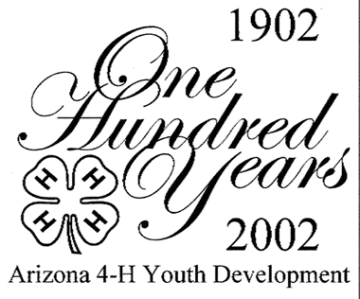Early Beginnings of 4-H
The First Decade: 1902-1912
In the late 1890’s and into the early 1900’s, 4-H programs began throughout the country in response to young people and their need for a better agricultural education. Boys and girls clubs were established to meet this need. This community club model engaged youth through “learning by doing.”

No one individual is credited with originating the 4-H program but rather the program was founded through collective efforts of several individuals over the course of few years.
In 1901, A.B. Graham, a school principal in Ohio, began to promote vocational agriculture in rural schools in out-of-school "clubs." In 1902, Graham formed a club of boys and girls with officers, projects, meetings, and record requirements. He sought assistance of the Ohio Agricultural Experiment Station and Ohio State University.
At the same time the club concept was adopted in Iowa by O.H. Benson in Wright County and Jessie Field Shambaugh in Page county.
Creating the 4-H Clover Emblem
In 1907 or 1908, the first emblem used nationally was designed by O. H. Benson as a three-leaf clover. It stood for head, heart, and hands. In 1911, Benson suggested that the fourth H should be hustle, and the 4-H Clover design was adopted.

Later O. B. Martin suggested that health replace hustle. The 4-H emblem has stood for head, heart, hands, and health ever since.
In 1912, O. H. Benson established federal-state-county programs through cooperative agreements, which tied the three entities of Extension work together. Twenty-eight such cooperative agreements between the Office of Farmer Cooperative Demonstration Work and the land-grant colleges promoted youth club work.
Organizing 4-H
The Second Decade: 1913-1922
Passage of the Smith-Lever Act of 1914, which established the Cooperative Extension Service of which 4-H is a part.
In 1918, first use of the term "4-H Club" in a federal document appeared in a bulletin written by Gertrude L. Warren.
In 1921, the National Committee on Boy's and Girls' Club Work was formed, which coordinated private support on behalf of 4-H type programs.
Organizing 4-H
The Third Decade: 1923- 1932
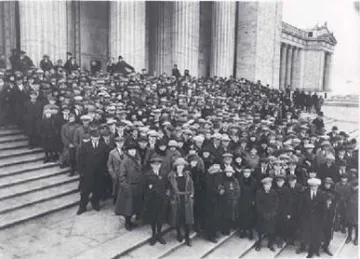
Following World War I, 4-H focused on organizing, including requirements for a standard club, roles of local 4-H leaders, and project experiences, all contributed to the management of club work.
National 4-H Club Congress grew out of two Annual National Tours.
In 1923, the Second National Boys and Girls Club Congress and Fifth Annual Tour became known as National 4-H Club Congress.
During this decade 4-H crossed the Atlantic and became established in Europe. Growth of 4-H began in Great Britain, Denmark, Finland, Sweden and Norway.
4-H Name and Emblem Patented
In 1924, club work had acquired the name of 4-H and the 4-H emblem was patented.
National 4-H Pledge and 4-H Motto Adopted
In 1927, State 4-H Leaders adopted the National 4-H Pledge and the 4-H Motto at the first National 4-H Club Camp.
First National 4-H Club Camp
In 1927, the first National 4-H Club Camp was held in Washington D.C. to recognize and develop junior leaders. Delegates were housed in tents on the grounds of the U.S. Department of Agriculture.
4-H Reaching Maturity The Fourth Decade: 1933-1942
During the 1930’s, the Federal Extension Service and the National Committee on Boys and Girls Club Work expanded their 4-H activities. The National Committee widened its range of projects and sought private support for 4-H. Extension 4-H Leaders moved to broaden the interest of 4-H’ers.
In the early years of 4-H, projects were mainly focused on canning, corn growing and livestock projects. In the 1930’s, expansion of 4-H projects for girls included offerings such as clothing, home management and improvement, food and nutrition, and other home economics projects. Expansion for boys included soil conservation, tractor, engineering, electricity and agricultural production projects.
America’s entry into World War II in 1941 halted any consideration of expanding domestic programs. 4-H, turned it’s attention to supporting the war effort. At the beginning of the war, 4-H established seven national war goals. Three of the goals dealt directly with the need to produce more food and other products for the war effort. Other goals, however, were aimed at helping young people define their citizenship responsibilities in the community. Throughout the country, 4-H clubs followed the slogan "Food for Freedom".
Although millions of young men and women joined the war effort, 4-H membership nevertheless increased. At the end of 1942, 4-H had enrolled over 650,000 new members for a total of 1.5 million.
4-H Learning by Doing The Fifth Decade: 1943-1952
In 1943, the number of youth participating in 4-H reached a peak of 1.6 million. By 1945, the number of young people successfully completing a project was over 76 percent.
As part of the war effort 4-H members contributed on their own through victory gardens and production-oriented projects, which significantly increased the harvest of food and fiber. As a part of their community responsibilities 4-H’er joined numerous campaigns to collect scrap iron and aluminum and to conserve use of scarce items essential to the war effort. Many 4-H’ers used earnings from their projects to purchase war bonds.
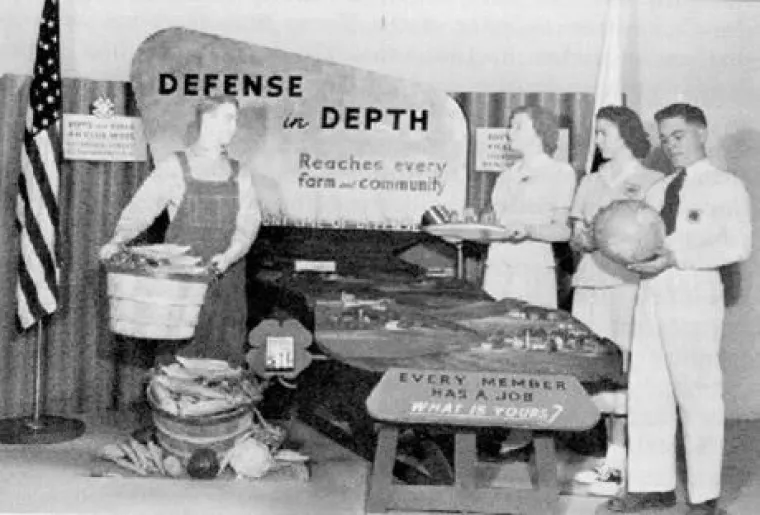
In 1951, the Chevy Chase Junior College was purchased as a site for a national 4-H training center by the National 4-H Club Foundation. This was dedicated the same year and later became the National 4-H Center.
Training for Tomorrow and Expanding 4-H Internationally
The Sixth Decade: 1953-1962
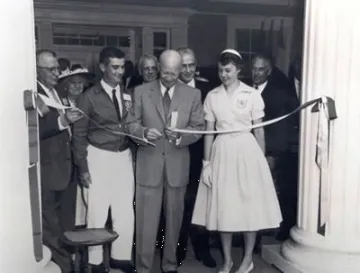
4-H continued its expansion nationwide, with special interest groups becoming one of the fastest growing 4-H delivery modes. Citizenship and emphasis in science in 4-H projects received special attention. Age requirements for 4-H members changed from 10-21 to 9-19 years of age.
Between 1944 and 1953, twenty-three countries in Asia, Europe, and Latin America established 4-H Clubs. Another thirty-eight countries, including several in Africa, initiated 4-H programs between 1953 and 1962. By 1965, 4-H type clubs existed in seventy-six countries with a total membership of over 4 million young people.
In 1959, the National 4-H Center opened just outside Washington, D.C., with President Eisenhower participating in the dedication ceremonies.
Challenges of the 60's and 70's The Seventh Decade: 1963-1972
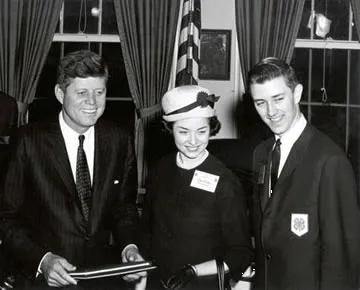
In 1965, Extension Committee on Organization and Policy and its 4-H subcommittee agreed on a policy to encourage participation of minorities in national 4-H events.
In 1966, a national workshop designed to expand 4-H for disadvantaged youth in both rural and urban areas was held in Chicago, IL.
Moving Toward "4-H in Century III" The Eighth Decade: 1973-1982
The National 4-H Pledge Changed, in 1973, the first change from the original wording of the National 4-H Pledge, adopted in 1927, added "…and my world" at the end of the pledge.
4-H Membership Grows, 4-H exceeded 7 million youth for the first time in 1974.
The Real World of 4-H The Ninth Decade: 1983-1992
In the ninth decade 4-H explored new technologies, the Computer Age, increased delivery modes, and had a major focus on National Extension Initiatives, particularly Youth at Risk. All of these continued to be emphasized in the years ahead.
The new Vision was "4-H…A world leader in developing youth to become productive citizens and Catalysts for positive change to meet the needs of a diverse and changing society."
A 4-H Alumni Study was a national evaluation done in 1985 about the long-term impact of the 4-H program, it concluded that the powerful effects of 4-H continues for decades.
4-H in a New Millennium to "Make the Best Better": 1993 - 2002
The 4-H youth development movement is celebrating its Centennial as one of our nation's longest serving youth development organizations. And it is doing so, not by building a monument to its history, but rather by organizing a National Conversation on Youth Development in the 21st Century.
The National Conversations on Youth Development in the 21st Century began September, 2001 with Local Conversations. Over 100,000 citizens participated in conversations in almost every one of the nation's 3,067 counties which centered on what can be done to improve each local community.
This was the first time any organization has developed a series of recommendations starting at the ground floor—where everyone lives—and it worked its way up to one national report. State Conversations were held next, with Conversations culminating on February 28—March 3, 2002, when over 1,600 individuals from every state convened in Washington, D.C. for the National Conversation. The Local, State, and National Conversation recommendations were compiled into one national report presented to President Bush, the Cabinet, and the U.S. Congress in April 2002.
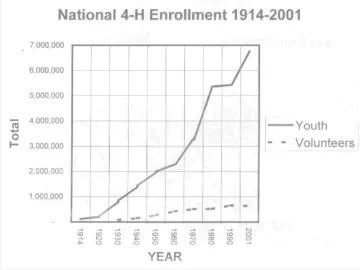
4-H didn't start at any one time 4-H or place, but has developed according to needs of people. It is the result of the work of many people in different parts of the United States who were concerned about young people, and its early history is an example of it's cooperative nature. The characteristics of 4-H are unique. From its inception, it tied both public and private resources together for the purpose of helping young people
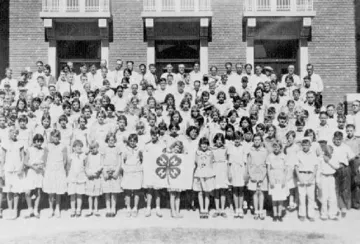
4-H Club members on the steps of the Agriculture building, 1931, The University of Arizona, Tucson Az.
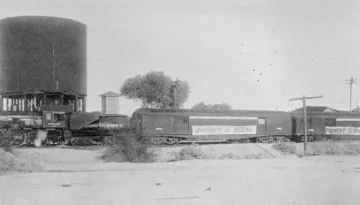
In the early years, 1912, the University’s Extension “Demonstration”
train traveled the state. By 1914 the Demonstration train grew to four cars, the first contained exhibits of hogs, cattle and sheep. The second carried fruits vegetables and farm crops. Various items of farm machinery exhibits were displayed in the third car and the forth car was used as a lecture room.
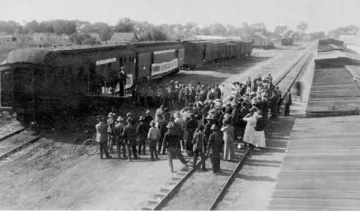
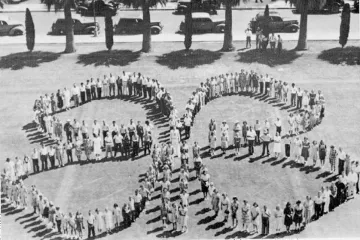
4-H Club members on the University of Arizona Campus, Tucson AZ.1937
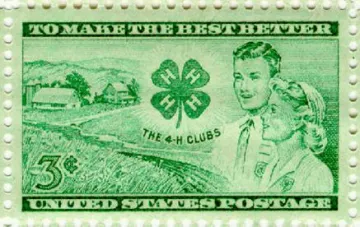
4-H Club stamp first issued January 15, 1952 to commemorate 50 years of 4-H.
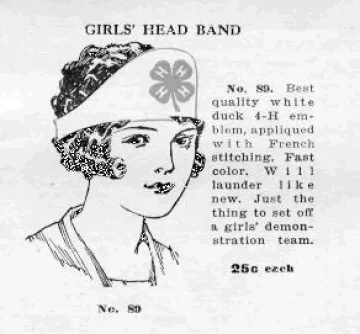
Girls Head Band circa 1930's
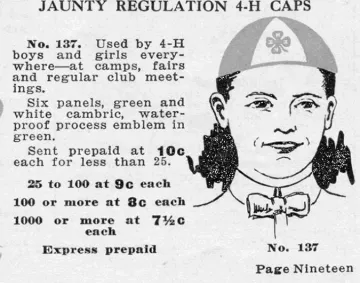
4-H Member’s Cap, circa 1930's
